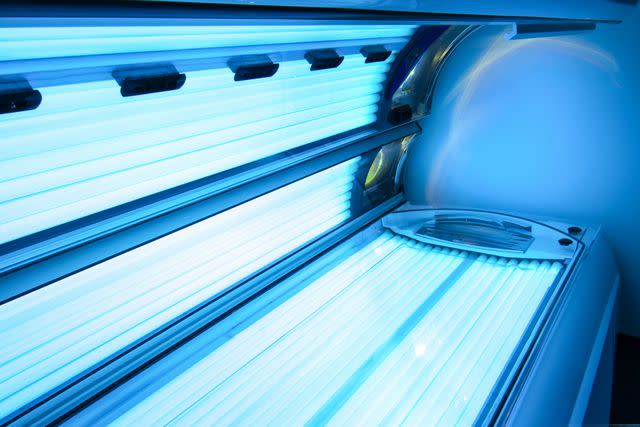Do Tanning Beds Really Help With Psoriasis Symptoms?
- Oops!Something went wrong.Please try again later.
Fact checked by Nick Blackmer
Reality TV star Kim Kardashian recently revealed that she has a tanning bed inside her office that she uses to help her psoriasis.
While the UV light that is emitted from tanning beds may help with symptoms of psoriasis, dermatologists do not recommend using tanning beds as a treatment for the autoimmune condition.
Tanning beds are directly linked to skin cancer, increasing the risk of the two most common types (squamous cell carcinoma and basal cell carcinoma), along with increasing the chances of developing melanoma, the deadliest type of skin cancer.
Kim Kardashian made headlines last week when she revealed she has a tanning bed inside her office—but the reality TV star said she uses it for medical purposes.
The saga started when Kardashian, 43, shared a video on TikTok. “I’m Kim Kardashian, of course I have a tanning bed—and a red light bed—in my office,” she said to viewers.
That was enough to rile up concerns.
“Please, Kim Kardashian, don’t try to normalize tanning beds,” Allure magazine said on Twitter, sharing a link to an article on the controversy.
Kardashian responded to the outlet. “I have psoriasis and it really helps when it’s bad,” she wrote on Twitter. “But I don’t use it too often.”
Allure was right—indoor tanning is linked to skin cancer. According to the American Academy of Dermatology, indoor tanning increases the risk of the two most common types of skin cancer—squamous cell carcinoma and basal cell carcinoma—by 58% and 24%, respectively. And using tanning beds before the age of 20 increases your chances of developing melanoma, the deadliest form of skin cancer, by 47%—a risk that increases with each use.
But was Kardashian right as well? Could indoor tanning help manage symptoms of psoriasis? Here’s what dermatologists want you to know before getting those artificial rays.

deepblue4you/Getty Image
Indoor Tanning and Psoriasis Symptoms
Psoriasis is an autoimmune condition that causes inflammation in the skin—skin cells multiply too quickly, and form scaly, inflamed patches. Ultraviolet (UV) light, according to Gary Goldenberg, MD, board-certified dermatologist and co-owner of Goldenberg Dermatology, can tamp down the skin’s immune system, which can then help decrease inflammation in the skin.
But, while the UV light may help relieve psoriasis symptoms, dermatologists do not recommend using tanning beds as a treatment for the condition.
“Tanning beds could result in some improvement of psoriasis symptoms,” said Ife J. Rodney, MD, board-certified dermatologist, dermatopathologist, and founding director of Eternal Dermatology + Aesthetics, “but there’s a big downside because you’re also getting other rays we don’t necessarily recommend.”
Tanning beds emit the same rays that reach the Earth’s surface from the sun—mainly UVA and lesser amounts of UVB—but tanning beds emit those dangerous rays at a much higher intensity than sunlight.
“[It’s like] taking the ultraviolet radiation from the sun that is millions of miles away and putting it within inches of your skin,” Cindy Wassef, MD, assistant professor of dermatology at the Rutgers Robert Wood Johnson Medical School, told Health. “Even one use can increase the lifetime risk of melanoma.”
Previously, UVA and UVB rays were used in “special circumstances” to treat psoriasis, said Joshua Zeichner, MD, director of cosmetic and clinical research at The Mount Sinai Hospital. “[But] the risks associated with the use of that light include the development of skin cancers, [and] for that reason, they have largely fallen out of favor,” Zeichner told Health.
Now, a treatment known as phototherapy is used. “Phototherapy that we use in the office is a specialized wavelength known as narrowband UV light,” said Zeichner. “This narrow and UVB light is considered to be safer than sunlight.” Narrow UVB light can also be used to treat other inflammatory skin conditions, like eczema and acne, but it may not work for others.
Spending time outside may also help with psoriasis symptoms, and though it’s slightly safer than using a tanning bed, it’s still important to do so with caution. For patients who may want to try sunlight exposure for psoriasis, Wassef recommends “limiting exposure time without sunscreen to no more than 15 minutes daily, and then applying sunscreen.”
UVA vs. UVB Light
Ultraviolet A (UVA)
Penetrate skin more deeply
Cause tanning and sunburns
Leads to premature aging and skin cancer
Ultraviolet B (UVB)
Penetrates and damages outermost layer of skin
Causes tanning, burning, and blistering
Also leads to skin cancer
Related: Sunscreen vs. Sunblock: What's the Difference, and Which One Is Better?
Seek Other Treatment Options for Psoriasis
Although indoor tanning has the potential to help relieve psoriasis symptoms, the risks far outweigh the benefits, and dermatologists strongly recommend against using it as a treatment.
“I do not recommend that someone with psoriasis go to a regular tanning bed to treat their skin,” says Zeichner. “Most tanning beds contain UVA rays that penetrate deep into the skin and are directly associated with the development of skin cancers and premature skin aging.”
If you have psoriasis, Rodney recommends talking to a dermatologist to help come up with a treatment plan that works for your particular symptoms. Topical treatments like cortisone and non-cortisone creams may help for localized flares, he added.
“From more moderate to severe psoriasis, systemic medications are available by prescription, either as a pill or by injection,” said Zeichner. “Narrowband UVB phototherapy is also an option that you can speak to your dermatologist about.”
The recommendation to avoid tanning beds isn’t just for people with psoriasis, either—it’s for everyone.
“They are extremely harmful to the skin. They accelerate aging and increase skin cancer risk,” said Wassef. “They are not a legitimate medical treatment and there are other safer options when it comes to using ultraviolet as a treatment for skin disease.”
For more Health.com news, make sure to sign up for our newsletter!
Read the original article on Health.com.

